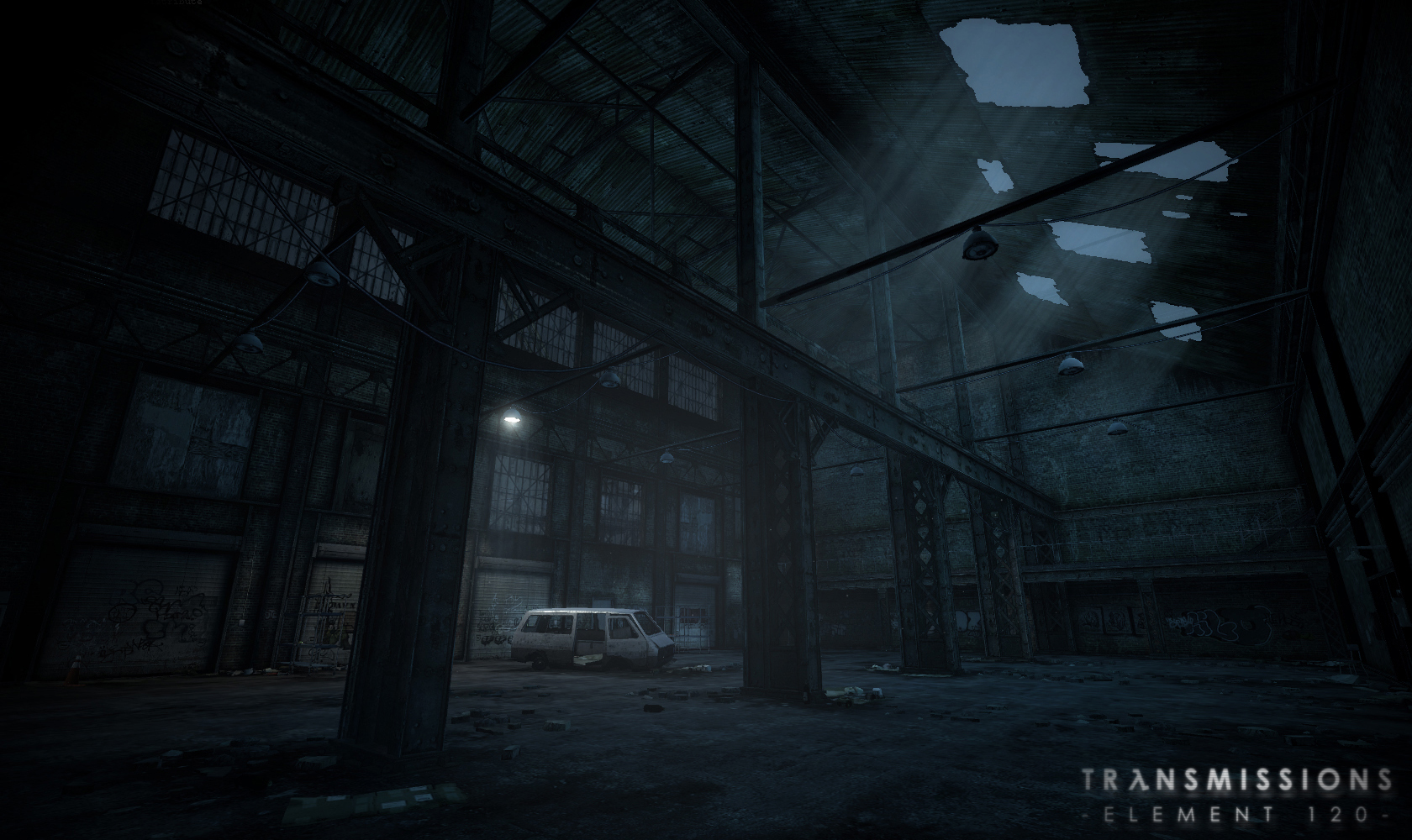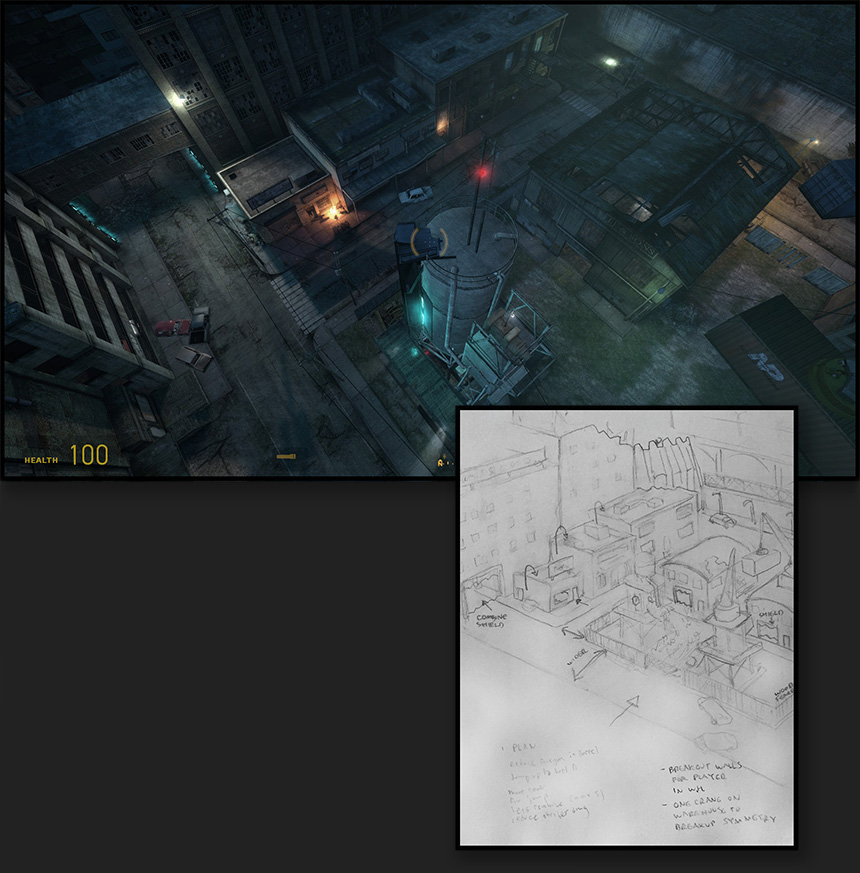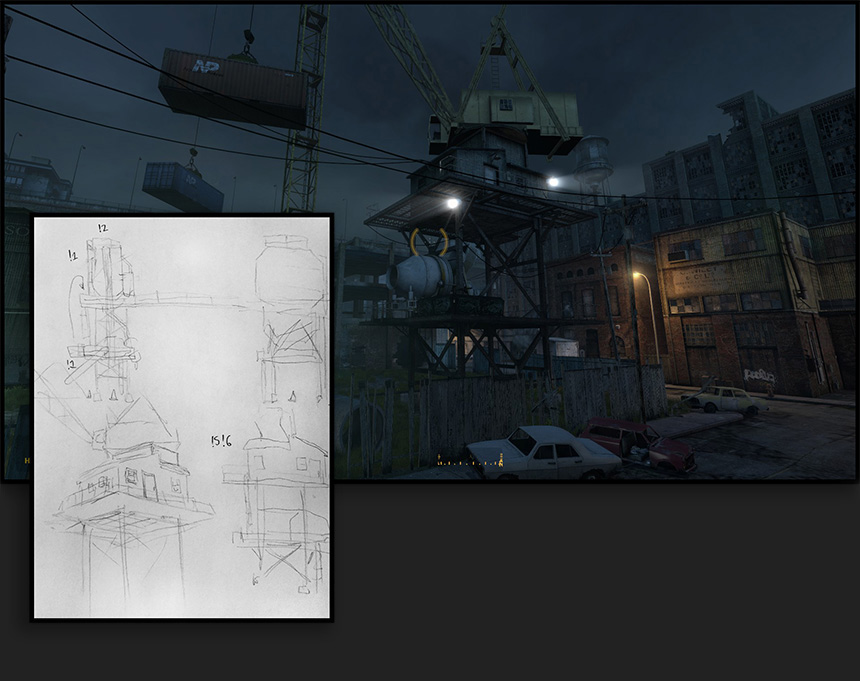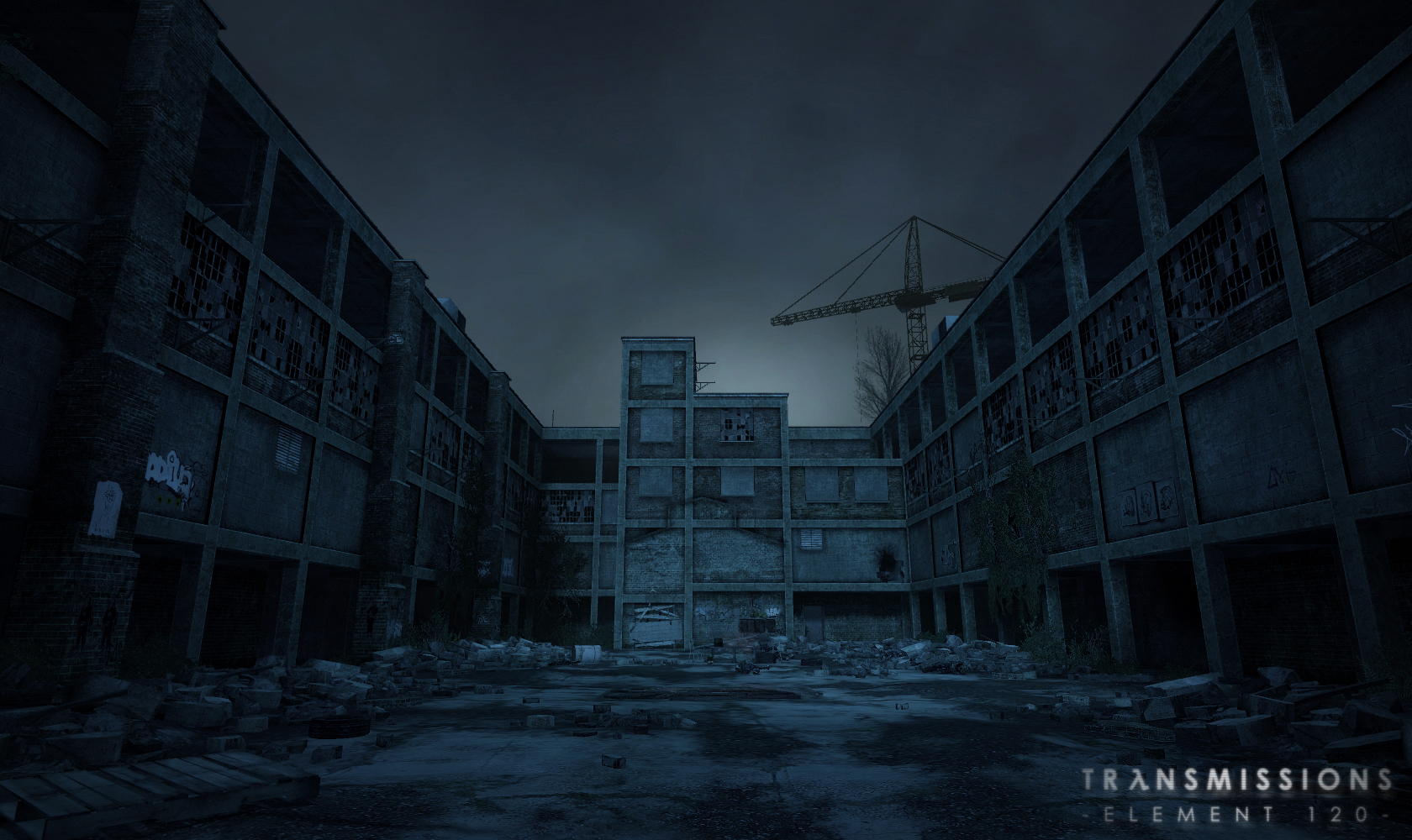Overview of Work
TE120 is the result of many nights & weekends creating custom levels, code, models, sounds, and more. TE120 was published on steam and now has over 1,000,000 downloads with a 94% approval rating.
Some of the major new features included are:
- Enhanced dynamic lighting
- Integrated Source Shader Editor 0.5 for gameplay fx, post processing, & lighting
- Modified physics system to support large objects, complex bodies such as scaffolding
- Stealth adjustments and new strider movement manager
Game Description
Transmissions: Element 120 is a short, free, single player experience set in the Half-Life Universe featuring a unique gravity defying weapon that allows you to jump buildings and sustain large falls. The story takes place at a mysterious date & location. Where are you? Why have you been sent?
Videos of Work
TE120 is approximately 45 minutes to 1.5 hours depending on play style. It consists of 4 maps, almost every area was built with custom meshes, custom code features, custom textures, and/or modification of existing assets.
Source files such as VMFS, C++ Files, and more are available upon request.
Features and Reviews
TE120 has been featured & reviewed on multi gaming websites:
- “When Transmissions ended, I cringed. I wanted more so, so badly.” –Kotaku
- TE120 made the frontpage of reddit and r/gaming earning millions of views.
- “A new mod called Transmissions: Element 120 was recently released, showing what a single developer can do with two years and a whole lot of dedication.” –GameInformer
- “Transmissions actually contains some very creative and engaging sequences, reminiscent of the action, drama, and even horror that originally drew us all to the world of Half-Life.” –IGN
- Multiple features on PC Gamer.
- 97% Average on RunThinkShootLive
- Featured on Rock, Paper, Shotgun
- “Set in a dark, eerie, atmospheric location at a mysterious time after Episode 2, Transmissions : Element 120 combines beautiful visuals with contextual narrative and action-packed gameplay…” –Lambda Generation
- “The use of QR codes for a particularly hair raising puzzle was really well done, my heart was in my mouth when a poison zombie clubbed me on the head in the pitch black darkness and dropped me to 9hp.” –ValveTime
- And many more sites: HardcoreGamer, MoviePilot.com, Tech Times, The Daily Dot, and more.
Design Process
Below is an outline of the general design process from concept to final.
Research
Research began with a plan to reverse engineer HL2 design pillars. This started with playing the game and asking questions like what is HL2 all about? The answers had words such as gravity gun, exploration, physics puzzles, environmental storytelling, mysterious narrative. There was also a general list of AI, puzzle types, & combat scenarios. These would be my constraints.
Product Vision & Prototype
From the start I knew I wanted to introduce a new mechanic and I wanted it to be focused on physics & movement. At the time I felt too many modern shooters were far too static. I started thinking of some of my favorite FPS games that required movement like Portal & Metroid Prime, but also older games like TFC & Quake.
I brainstormed several ideas, one of which included the new weapon, and filtered them against the pillars from the research stage. The items that didn’t have a place for both puzzles & combat were screened out. The items that didn’t emphasize physics interactions like the gravity gun were also screened out.
The weapon, a mix between a rocket launcher & the TFC concussion grenade, was one of the first things to prototype. Multiple combat & puzzle scenarios were tested to build confidence with it as the basis for this game.
Throughout this process I was also building a level design zoo, collecting as many assets as possible into a single map. This was extremely helpful in brainstorming environmental & narrative ideas and to build within the constraints of the HL2 direction. While in this map it was really interesting playing with dynamic light to inspect various assets. I thought something as simple as the flashlight was underutilized and could produce compelling moments. After discovering multiple people had already made code changes to dynamic lights, enabling more than one light with greater quality, it helped cement ideas for a project theme.
- Early on I decided to try for a gameplay, story, and visual theme of light & darkness.
- My desire was to tell a darker story of a world in conflict with humans clearly losing but where “the right man in the right place could make all the difference”. If Gordan is a tool for the Gman, then I decided early on it would be interesting to play with the idea that you’re like a monster sent on a pre-determined path to unleash destruction.
- Puzzle ideas were tested early where you had to utilize light & darkness to proceed but, like a monster, generally staying concealed in darkness is the solution.
- When the player finally obtains the new weapon, obtains power, I wanted players to feel a sudden tone change in gameplay & lighting. No longer are you hiding in the dark, you’re ugly & in the open creating havok.
- Finally, I wanted to try my best to create a visual experience as close to modern day as possible and thought the use of dynamic lights could help make this achievable. I hoped that, at least partially, fans would be satiated in their desire for a sequel to Half-Life 2. So long as the effort complimented gameplay & story, I thought it would be worth it.
Paper Design
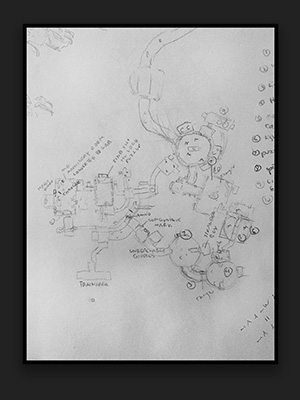
Paper design was brief, generally I believe getting to 3d and iterating is where success is found, but 2d layouts are a great way to collect thoughts and start a plan.
This began with collecting reference images from the HL2, inspiring real world locations, and other games. Much of TE120 was visually inspired by abandoned sections of Detroit. I drew up a 2d layout with puzzles conceived during prototype, major combats placement, and story ideas. This also mapped the introduction & teaching of new mechanics. The what, where, why, and when.
Blockout & Gameplay
The majority of the project was spent here. The entire plan was roughly blocked in. Getting it into 3d revealed several problems about critical path, puzzles, combat design, etc. A second higher detail blockout pass began directly after along with gameplay. I choose many of the most important areas first then jumped around to different areas in between.
In many instances I’d sketch out 3D perspectives on rooms/areas to get a rough idea of what I’m building before blockout. Nothing note worthy from a concept art perspective, but it’s a handy tool for myself to quickly visualize spaces & shapes before going to 3D.
An objective for the final combat was to get a cat (strider) & mouse (player) gameplay dynamic. The layout was purposely kept in a simple grid pattern so players could quickly orient themselves when seeking cover.
While iterating on gameplay in this stage I always try to put myself in the customers shoes. What would they be thinking? Purposely testing differently and even from a different desk position can reveal new perspectives & ideas.
Early Focus Testing
I had several volunteers test the project during this earlier phase, providing feedback on the weapon, layout, puzzles, etc. After each test, I’d adjust and have another test.
Art/Production
The art phase began with more reference image gathering. Generally environments were first roughly lit and then textured. Once happy with an areas general look, final proping, lighting, decaling, and post processing went in.
- Gameplay must not be compromised but try to have both.
- Rule of Thirds & Golden Ratio. Look for composition opportunities from viewpoint near doorways & entry ways.
- First & Second Read Primary Focus Elements. What’s the main subject of the scene?
- Flow. Where is the players eyes looking & moving when they enter an area? Lighting generally is a major tool here.
- Dominate & Sub-Dominate masses, try to mix up the large shapes.
- Balance of small, medium, and large details. Where will they go? What’s the small detail?
Final Focus Testing
Semi-public betas were held on mapping forums for the final focus testing. Volunteers played through the entire campaign, recording videos, and then finished by answering a question sheet. Spots of confusion, dissatisfaction, and general blockers were highlighted and addressed. There were three different beta tests until I felt confident in the result.
Marketing and Release
The trailer was put together, primarily in Adobe Premiere, and it was sent along with a small set of screenshots to almost every major gaming website. Communicating & preparing assets for multiple websites was far more work than I expected. Having almost no marketing experience throughout my professional career this gave me a new perspective for the amount of work this takes.
Postmortem Thoughts
Moving to the art/production pass too soon was problematic. Not all issues were revealed and some appeared to be less critical since the experience was not refined. As a result this led to a major change in the weapon design & a complete overhaul of the final half of the campaign. This change reset progress back to the blockout phase. It also made adjustments to the areas I kept very difficult.
A good example issue was the final puzzle in chapter 1. In this puzzle the player is required to turn off the lights and jump in a pit with zombies to open a door. I tried to teach that zombies cannot see the player before this puzzle but it could be missed and many players were confused or blocked. With the art pass already complete and much of the level looped on itself it was too difficult to make optimal changes to help teach these skills. I made changes to the final steam version to massage these issues but I was never completely happy with the final result.
To me great gameplay is what makes games stand the test of time. When compared to the total project length, the final art passes were relatively fast. A big takeaway for me is to not be afraid of throwing away completely polished sections of a level. I believe TE120 would not have got the attention it did without some of the visual polish but most of that work could have been redone relatively fast.
Another key takeaway was to not be too eager, refine the experience to as close to final as possible while balancing flexibility. The goal is to test as objectively as possible. Once you believe with absolute confidence you have a great game, only then should you begin a final polish pass.
How to Play
The game can be downloaded for free from the steam store page.

